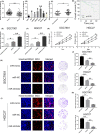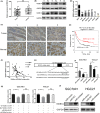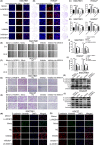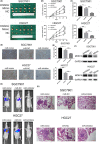miR-664a-3p functions as an oncogene by targeting Hippo pathway in the development of gastric cancer
- PMID: 30883979
- PMCID: PMC6536452
- DOI: 10.1111/cpr.12567
miR-664a-3p functions as an oncogene by targeting Hippo pathway in the development of gastric cancer
Retraction in
-
RETRACTION: miR-664a-3p functions as an oncogene by targeting Hippo pathway in the development of gastric cancer.Cell Prolif. 2024 Jul;57(7):e13681. doi: 10.1111/cpr.13681. Epub 2024 May 28. Cell Prolif. 2024. PMID: 38804819 Free PMC article.
Abstract
Objectives: It has been accounted that miR-664a-3p has different functions in several malignancies; however, the precise role and underlying mechanism in gastric cancer have not been elucidated. Our study aims to explore the function of miR-664a-3p on the progression of gastric cancer (GC).
Methods: qRT-PCR was applied to detect the expression of miR-664a-3p in GC tissues and cells. The functions of miR-664a-3p on GC in vitro were examined by cell proliferation assay, and transwell assay. Related proteins of epithelial-mesenchymal transition (EMT) and signal pathway were evaluated by Western blot and immunofluorescence analysis. The bioinformatic, dual-luciferase assay or ChIP assay were employed to identify the interaction between miR-664a-3p and its target gene or Foxp3. The effects in vivo were investigated through a mouse tumorigenicity model.
Results: miR-664a-3p was frequently upregulated in GC tissues and cells. Elevated expression of miR-664a-3p significantly promoted proliferation and invasion in vitro and in vivo. MOB1A was confirmed to be a target of miR-664a-3p and restoration of MOB1A attenuated the effects of miR-664a-3p. A series of investigations indicated that miR-664a-3p contributed to EMT process and inactivated the Hippo pathway by downregulating MOB1A.
Conclusion: Taken together, we revealed that miR-664a-3p functions as an oncogene by targeting Hippo pathway in the development of gastric cancer.
Keywords: GC; Hippo; MOB1A; metastasis; miR-664a-3p; proliferation.
© 2019 The Authors. Cell Proliferation Published by John Wiley & Sons Ltd.
Conflict of interest statement
The authors declare that they have no conflict of interest.
Figures







References
-
- Torre LA, Bray F, Siegel RL, et al. Global cancer statistics, 2012. CA Cancer J Clin. 2015;65:87‐108. - PubMed
-
- Van Cutsem E, Sagaert X, Topal B, et al. Gastric cancer. Lancet. 2016;388(10060):2654‐2664. - PubMed
-
- Ferlay J, Soerjomataram I, Dikshit R, et al. Cancer incidence and mortality worldwide: sources, methods and major patterns in GLOBOCAN 2012. Int J Cancer. 2015;136:E359‐E386. - PubMed
-
- Ikoma N, Blum M, Chiang Y, et al. Race is a risk for lymph node metastasis in patients with gastric cancer. Ann Surg Oncol. 2017;24:960‐965. - PubMed
-
- Glockzin G, Piso P. Current status and future directions in gastric cancer with peritoneal dissemination. Surg Oncol Clin N Am. 2012;21:625‐633. - PubMed
Publication types
MeSH terms
Substances
Grants and funding
LinkOut - more resources
Full Text Sources
Medical
Miscellaneous

